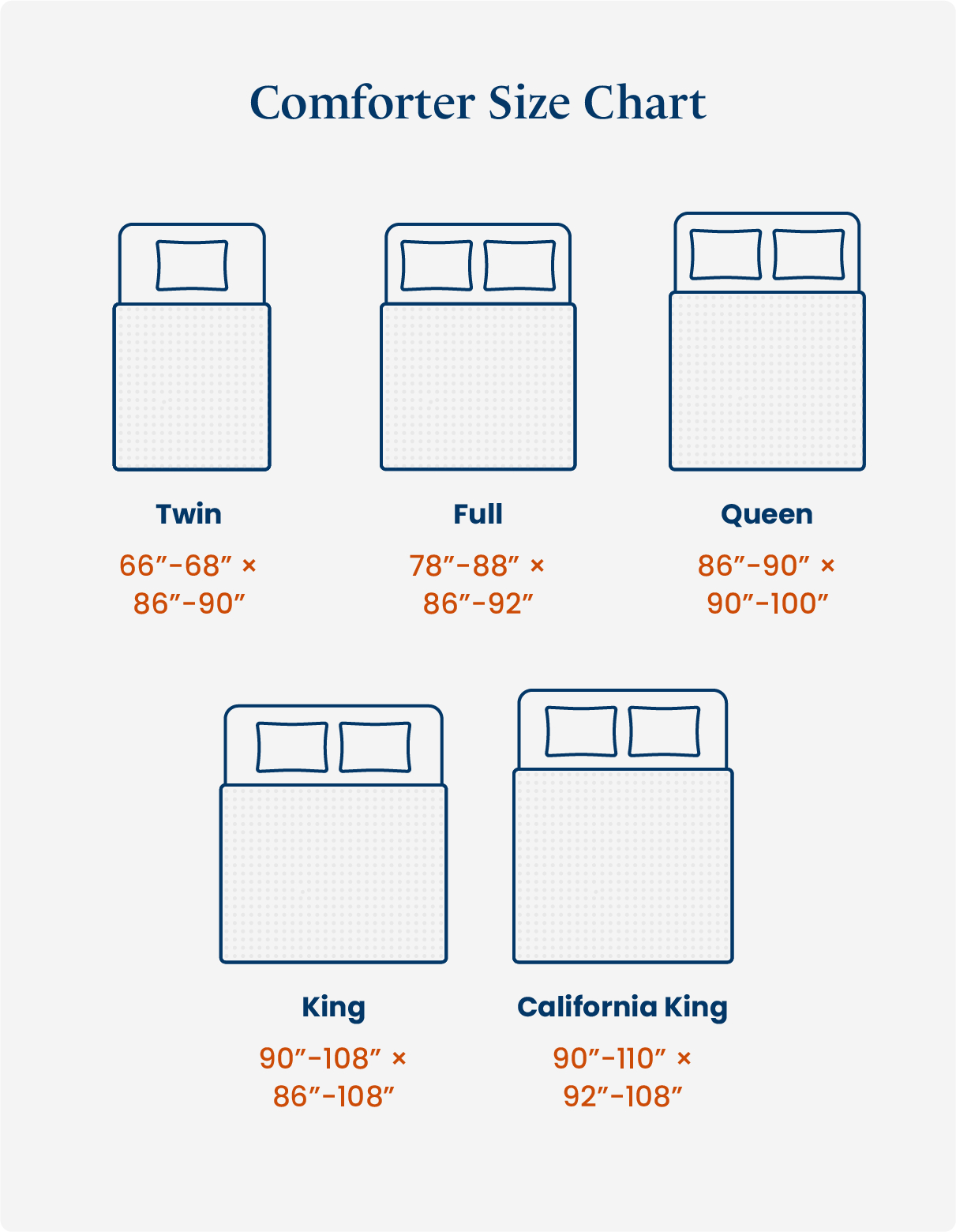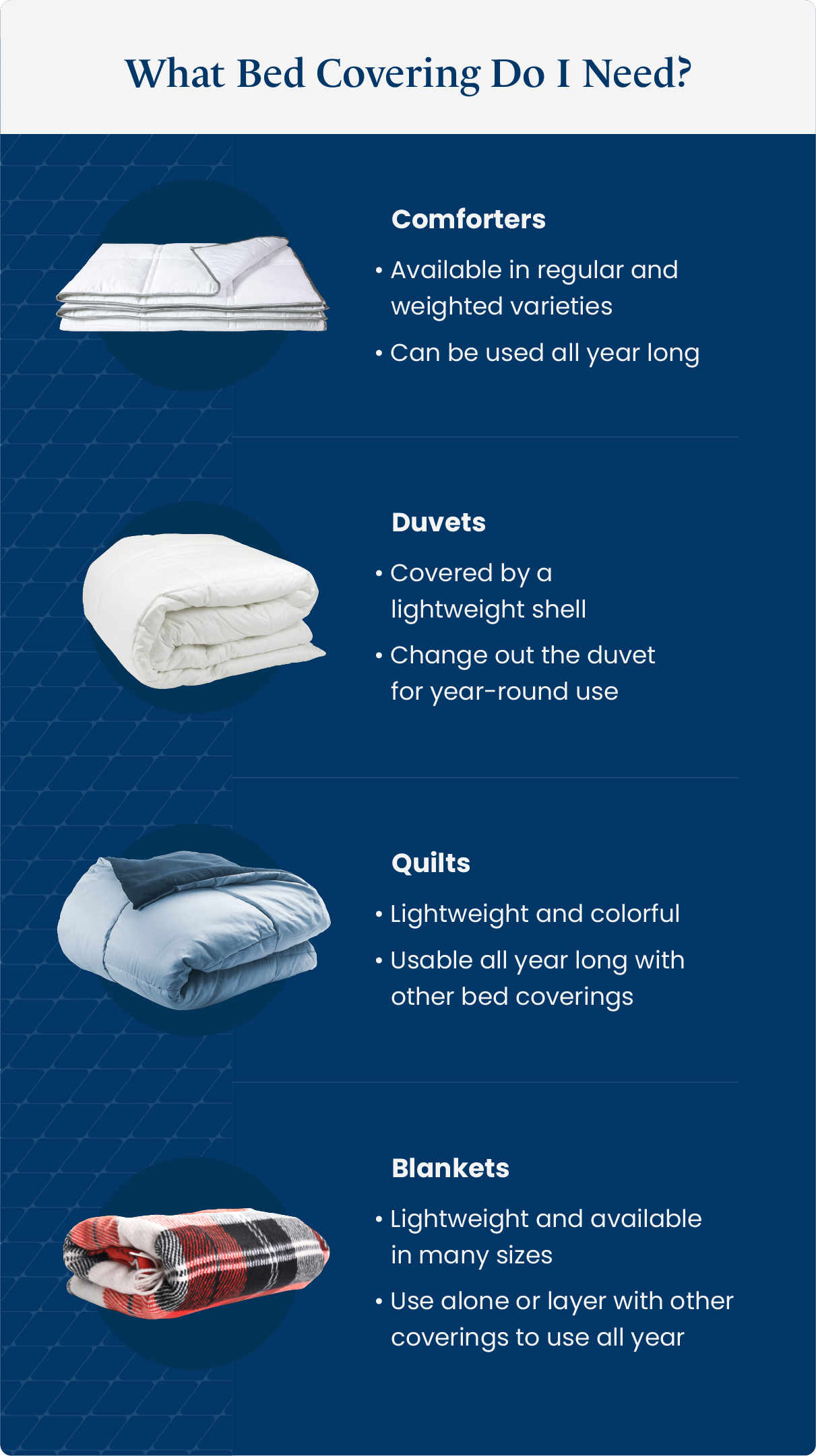Your comforter is much more than the top layer of your bedding. It’s there to keep you comfortable, and it lets you inject your style into your bedroom. But how do you choose the right size for your bed? We’ll provide an easy-to-follow comforter size guide for finding the perfect comforter for any mattress.
We also discuss your other bed covering options, including blankets, duvets, and quilts, so you can choose what will keep you comfortable and help you get the best night of sleep.
Comforter Size Chart
Comforter sizes are based on mattress sizes, meaning that a king comforter will fit on a king bed. However, different manufacturers create comforters that are larger than others to provide more drape. This can make it harder to run to the store or jump online and order a comforter made specifically for your mattress, especially if you want a longer one.
Start with the size of your mattress to see if a regular or weighted comforter will be too big or too small. Then, double-check the comforter dimensions to make sure it will have the drape you want before you buy.
| Size | Mattress Size | Comforter Size |
|---|---|---|
| Twin | 38” x 75” | 66”-68” x 86”-90” |
| Twin XL | 38” x 80” | 68” x 86”-90” |
| Full | 54” x 75” | 78”-88” x 86”-92” |
| Queen | 60” x 80” | 86”-90” x 90”-100” |
| King | 76” x 80” | 90”-108” x 86”-108” |
| California King | 72” x 84” | 90”-110” x 92”-108” |

Considerations for Choosing a Comforter
Choosing a comforter isn’t as simple as just finding the right size. If you want it to look good and keep you comfortable at night, there are several factors to keep in mind. Let’s take a look at some of the elements to consider when shopping for a comforter.
Bed Setup
Part of the reason there are no standard comforter sizes is because of the variance in mattress thickness. If you like the look of a bed covering that cascades over the sides of your mattress nearly to the floor, you’ll probably need an oversized comforter, especially if your mattress is extra thick. Don’t forget about the bed frame, too, as taller frames mean you’ll need larger comforters if you want them to drape farther down.
Always check that a comforter will provide enough drape length (the amount of material that hangs over the edge) to hang over as much of the mattress and bed frame as you prefer by measuring the mattress thickness and frame before purchasing.
Material
Comforter fill comes in several materials, including natural and synthetic fibers. The fillings vary in how much warmth they retain, so keep that in mind when buying to make sure you aren’t sweating at night in the summer and shivering in the winter.
Natural materials like cotton offer breathability, while synthetics can be hypoallergenic and easier to care for.
Weight
The weight of a comforter is another important factor. While many people like having a lightweight comforter that they barely notice, using a weighted comforter might help you sleep better. The gentle, constant pressure that a weighted comforter provides can reduce tossing and turning and lead to a more restful night.
Fill Power
Fill power is the volume of filling inside of a comforter. Fill power is represented by a number from 350 to 900. A higher fill power usually means a fluffier, warmer comforter. Certain materials are lighter and more breathable, so it is possible to get high-fill-power comforters that are less warm.
Warmth and Breathability
Comforters come in different warmth levels (usually lightweight, medium, and heavyweight) to help you sleep comfortably, depending on the season and your personal preferences.
One of the factors that impact a comforter’s warmth is its breathability. Cotton and Tencel are light and breathable, making them good choices for a summer comforter. Down and wool are heavier and less breathable, meaning heat stays trapped under them.
Price
Comforter prices vary depending on size, material, and fill power. Set a budget and prioritize the most important features to you, but remember that investing in your bedding is an investment in your health and happiness. Spending a little more might mean better and more restful sleep night after night.
Which Bed Covering Do I Need?
With all the choices of bed covering available, picking the one that’s right for you isn’t as straightforward as you’d think. The best option for you might change from season to season based on the temperature outside, or it may change based on your style. Below, we cover a few of the most common bed coverings and discuss when they might be appropriate.
Comforter
Best for: Year-round comfort
While a big, puffy comforter might seem like it’s only for the coldest months of the year, they are available in different materials for year-round comfort. You can choose a down or down-alternative fill wrapped in breathable cotton for an all-around comforter or have a few comforters you can change out as the seasons change. A weighted comforter offers an extra level of comfort that reduces stress and anxiety.
Duvet
Best for: Year-round comfort (with changeable inserts)
Duvets offer a more lightweight and customizable sleep experience. They come in sizes to match your mattress and often feature a cotton or microfiber duvet cover.
One of the best parts of a duvet is the insert, which you can swap out to customize your bedding as the seasons change! A down or down-alternative insert will keep you warmer in the cooler months, while a lightweight cotton insert is perfect for comfortable sleep during warmer weather.
Quilt
Best for: Warmer months, layering
Quilts come in nearly any size and usually feature beautiful patterns. Their lightweight construction makes them ideal for layering your bed coverings so you’re ready for cool and hot nights. If you sleep warm, a quilt might be what you’ve been searching for.
Blanket
Best for: Warmer months, layering
Blankets are one of the more versatile bed coverings. They are available in sizes perfect for mattresses or as oversized statement pieces. You can buy blankets in many materials, from fleece to chunky wool, and you can even find weighted blankets. Blankets are great for layering on colder nights or as a lightweight option during warmer weather.

Sleep Better With a Weighted Comforter
By considering your personal preferences, the factors we've looked at, and the comforter size chart, you can find the perfect balance of warmth, weight, and material for your bed covering. If you want a better night’s sleep, order a weighted comforter today.





















